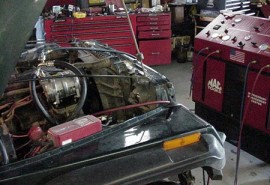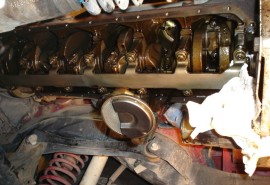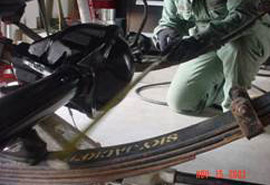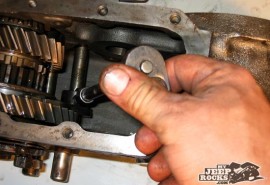Jeep Articles & News
Jeep Camping Gear FAQs
The question is best answered when the specifics of time and place are known, but in Southern California the same gear can easily get you through spring, summer, fall, and even winter in lower elevations.
Preparing Your Gear
When preparing your gear, the most obvious and limiting factor is the size of your vehicle. Plus, the lighter you pack, the easier it will be to quickly find the gear you need out on the trail. Also remember that “you get what you pay for,” so if you’re going to be camping often, be prepared to spend a little extra, it will be worth it in the end.
The Tent
We’ll start with perhaps the most important area of the camp: the tent. A poor night’s sleep can hinder the following day’s fun-level. Who says sleeping under the stars can’t be comfortable? The first question you need to answer is, “will I be able to put stakes in the ground?” If the answer is no, like on the Rubicon Trail, be sure to choose a free-standing tent.

When it comes to setup, a tent that clips to the poles has the fastest launch time. You may need a bigger tent if you want to run a portable heater or are bringing additional people along.
Sleeping Mattresses
Now let’s climb in the tent and get comfy. Therm-a-Rest’s camp mattresses are self-inflating, reliable, compact and very easy to carry. These and similar mattresses provide excellent support and warmth in a small package. There are also accessories to hook two together for a couple’s night out. A full size air mattress is another option but are a little more time consuming to set up – look for dual-chamber options. For starters, or infrequent campers, the blue foam pads ($8) also work to keep the earth from poking at your back. If you expect rain or damp weather, put a tarp down under your tent. Be sure to pull your shoes in at night!
Sleeping Bag
Choosing a sleeping bag really depends on where and when you’ll camp most often. If you hate going to the dry cleaners, make sure to get one that’s machine-washable! If you’re the type that gets cold during the night, or plan to camp in the mountains, look for a bag with a lower temperature rating. Springtime usually means great sleeping bag deals at Costco in their camping section. If you plan on sleeping with your significant other, choose a couple bags of the same brand that can most likely zip together. Carry a sleeping bag liner or a simple bed sheet along for the extra feeling of “home.”
Camp Pillows
Camp pillows also depend on each person’s needs. We’ve found that the tiny ones are compact but uncomfortable. Coleman makes a travel pillow ($10) which is about half the size of a regular bed pillow, and we found that to work best.
Meals
 Now that camp’s set up, it’s time to eat. Prepare your menu beforehand and bring only the gear you need. Don’t forget to bring drinking AND cooking water. It is recommended that you carry a gallon of drinking water per person, per day. Carrying two coolers works well for longer trips – drinks in one and food in the other. A Coleman stove or other portable grill ($20+) will cook just about anything from Hamburger Helper to quesadillas. For a more serious cook, check out the Coleman Dual-Fuel Stove. Pictured here is a grill basket, which works great provided you’re in an area that allows open fires. Fuel type is really based on user preference, and always remember a lighter. If you plan to cook on the fire, pack wood or charcoal and a fire starter. If you’re an experienced or even a practicing chef, consider a dutch oven.
Now that camp’s set up, it’s time to eat. Prepare your menu beforehand and bring only the gear you need. Don’t forget to bring drinking AND cooking water. It is recommended that you carry a gallon of drinking water per person, per day. Carrying two coolers works well for longer trips – drinks in one and food in the other. A Coleman stove or other portable grill ($20+) will cook just about anything from Hamburger Helper to quesadillas. For a more serious cook, check out the Coleman Dual-Fuel Stove. Pictured here is a grill basket, which works great provided you’re in an area that allows open fires. Fuel type is really based on user preference, and always remember a lighter. If you plan to cook on the fire, pack wood or charcoal and a fire starter. If you’re an experienced or even a practicing chef, consider a dutch oven.
Utensils
Pots, pans, and utensil sets exist in just about any camping gear aisle. Both pots fit inside each other for compact storage! You can even use your old kitchen pots and cooking utensils from home, until you figure out what works best for your menu. The famous blue enamel camping plates, cups and bowls are not only sturdier than paper plates, obviously, but are easy to clean. Remember, the less trash you create, the less you’ll have to carry on your adventure. Bring extra trash bags! Grab a cheap set of dinnerware ($5-15) and it will serve you well for many years to come. Paper towels don’t blow away as easily as a pile of napkins.
Clean-Up and Sanitation
 Environmentally friendly dish soap and a sponge/rag are a must, since ordinary dish soap and shampoo are not environmentally safe. Look for a bottle labeled camp soap ($3) or “biodegradable soap/shampoo” at your local outfitter.
Environmentally friendly dish soap and a sponge/rag are a must, since ordinary dish soap and shampoo are not environmentally safe. Look for a bottle labeled camp soap ($3) or “biodegradable soap/shampoo” at your local outfitter.
 Collapsible camp sinks (about $10) are also great for conserving water. Bring towels, but not your favorite bath towels, they will get dusty, dirty and most likely stained with grease in no time. Finally, find a couple of clear stackable plastic containers, and make sure all of your cooking gear fits nicely inside. That way, everything you need stays together.
Collapsible camp sinks (about $10) are also great for conserving water. Bring towels, but not your favorite bath towels, they will get dusty, dirty and most likely stained with grease in no time. Finally, find a couple of clear stackable plastic containers, and make sure all of your cooking gear fits nicely inside. That way, everything you need stays together.
As the campfire gets started and it’s time to relax, a solar camp shower ($6-100) is perfect for washing the dust off of your feet, as well as rinsing the dinnertime dishes. Many popular water bladder manufacturers now sell shower attachments too – we find them to be a bit more reliable. Here is also where your towels can come in handy. Everyone needs a camp chair ($10+), and be sure to weigh size into your decision. They come in all shapes and sizes!
 If you’re in an area without facilities, a portable camp toilet ($15-$90) like the OutBack Pack is quick to set up, easy to use, and alot of the time mandatory to carry. Couple it with a portable shelter like the one pictured here ($20-$40) and you’ve got a deluxe camp restroom! Always remember, don’t pollute, and don’t leave your tissue paper on the trails!
If you’re in an area without facilities, a portable camp toilet ($15-$90) like the OutBack Pack is quick to set up, easy to use, and alot of the time mandatory to carry. Couple it with a portable shelter like the one pictured here ($20-$40) and you’ve got a deluxe camp restroom! Always remember, don’t pollute, and don’t leave your tissue paper on the trails!
Finding Your Way in the Dark
Now that the sun’s down, the Coleman Tent Light (left) is a perfect magnetic light. These also stick great to jeep rollbars! No fumbling for the flashlight, just reach up and there it is! A headlight is also a great investment, ranging from $6-$60+. Even the inexpensive ones put out a nice beam of light and free your hands to set up camp. Splurge on a nice lantern ($35-90) if you can, flashlights just don’t cut it when cooking or setting up in the dark.
Troubleshooting
What if something goes wrong? Odds are, someone in your group will be able to help you out, but don’t count on it. Always check the conditions before you head out.
- Bring extra food and drinks.
- Assemble a first aid kit, even if it’s small, and always carry it with you.
- Don’t forget tissue, pain reliever, allergy and/or other medication.
- Bring an extra pair of shoes and socks. Sore or wet feet will make you miserable.
- Attach a fire extinguisher to the roll bar in your Jeep. (Check out Costco)
- Depending on your area, carry a snake bite kit and/or bear bags, etc.
- A CB, dual-band amateur radio or FRS radio (weatherproof, if possible) is the best way to keep in contact on the trails, and may be a prerequisite on organized trail runs. We like the little Uniden CBs, and don’t forget the antenna. From our experience, they all work great on the trails.
Printable Packing List
Keep it all together with your very own packing list.
Most importantly, tread lightly and have fun.







